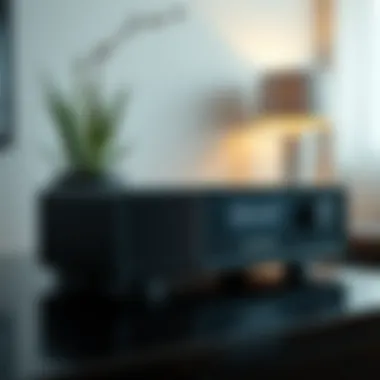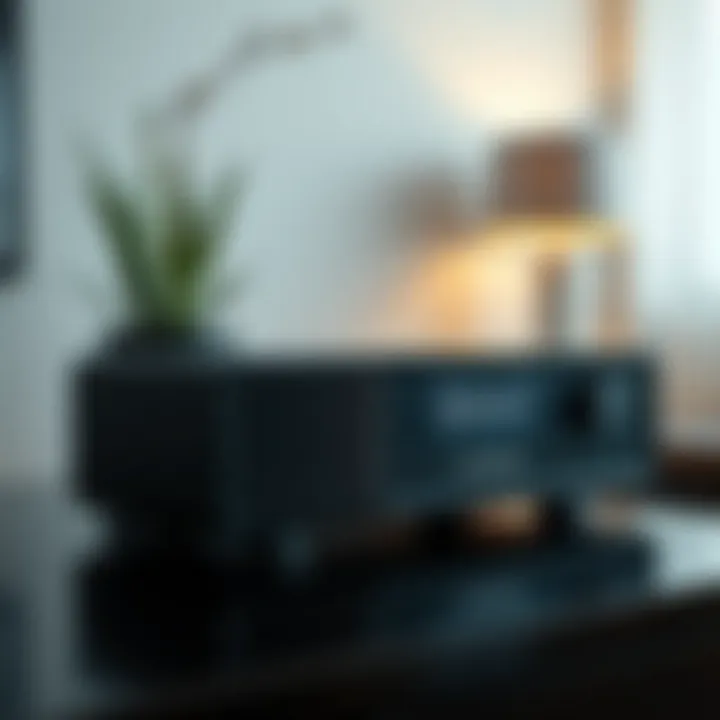In-Depth Look at Wireless Bluetooth Stereo Systems


Intro
In today's fast-paced world, the craving for high-quality sound without the clutter of wires has never been more significant. Wireless Bluetooth stereo systems have emerged as a popular choice for homeowners, designers, and DIY enthusiasts alike. They bring together convenience and superior audio performance, tailoring to the diverse needs of modern living spaces. This article will unpack the intricacies of wireless Bluetooth stereo systems, diving into their technology, features, and the advantages they offer.
Through analyzing suitable models, providing setup guides, and sharing maintenance tips, readers will find invaluable information whether they're casual listeners aiming for enhanced audio experiences or dedicated audiophiles seeking the very best in sound quality. By the end, you’ll be equipped with a solid understanding of how to select and optimize a Bluetooth stereo system that seamlessly integrates into your home.
Furthermore, we will explore the role of furniture design trends that complement these audio systems, as well as offer buying guides tailored to different budgets, ensuring that you make informed decisions for your audio needs and aesthetic sensibilities.
Prelude to Wireless Bluetooth Stereo Systems
In today’s fast-paced world, the way we enjoy music has undergone a remarkable transformation. Among these advancements, wireless Bluetooth stereo systems have carved a niche, becoming the go-to choice for enthusiasts and casual listeners alike. The blending of modern convenience with sound technology offers homeowners, designers, and DIY enthusiasts the possibility to create harmonious living spaces filled with music without the hassle of untangling wires. This article explores the key elements that define these systems, their history, and the convenience they bring to our daily lives.
Definition and Overview
A wireless Bluetooth stereo system is a set of audio equipment that communicates wirelessly through Bluetooth technology, allowing devices to connect without physical cords. Simply put, it enables seamless streaming from smartphones, tablets, and computers to speakers. These systems can range from portable setups designed for on-the-go use to sophisticated home installations that serve every audio need.
The appeal lies in the ease of use and flexibility. Imagine hosting a gathering where your favorite tunes create an electrifying ambiance, all while trailing behind you is not a web of cables. Not to mention, with numerous devices available in the market, users have a broad array of choices, tailoring setups to match individual tastes and spaces.
Historical Context of Bluetooth Technology
The journey of Bluetooth technology dates back to 1994 when it was first developed by a team at Ericsson. Originally intended as a wireless alternative to RS-232 cables, it has evolved tremendously over the decades. Fast forward to the early 2000s, when Bluetooth began to make its mark on the consumer market, facilitating wireless audio with the launch of several significant devices. By 2010, Bluetooth 3.0 and later versions equipped devices with advanced audio capabilities, enhancing sound transmission while significantly reducing latency.
The evolution did not stop there; we now have Bluetooth 5.0 and various profiles that allow users to experience high-definition audio streaming. As technology progressed, there came more interest in wireless stereo systems—an increasing trend led by convenience, style, and adaptability to modern households.
"Bluetooth has paved the way for a new era in audio experiences, transforming how we share and enjoy music in our environments."
Understanding these foundational aspects sets the stage for a deeper dive into specific features and setup considerations, ensuring that potential buyers are not only informed but empowered to make decisions that best suit their audio lifestyle.
Understanding Bluetooth Technology
Understanding Bluetooth technology is integral to comprehending the landscape of wireless Bluetooth stereo systems. As the backbone of communication in these systems, Bluetooth technology ensures that audio devices can interact seamlessly, paving the way for a user-friendly experience filled with potential for connectivity and versatility. It's not just about sending sound waves; it's about creating a network of devices that work together, which is ideal for homeowners and DIY enthusiasts looking to enhance their audio experience without the hassle of wires.
Basic Principles of Bluetooth Communication
Bluetooth operates on radio waves in the 2.4 GHz frequency range, which is unlicensed and widely used for various devices like mobile phones and wireless earbuds. When two Bluetooth devices want to communicate, they go through a pairing process, establishing a secure connection that allows for data transmission within a limited range. This makes Bluetooth perfect for home audio systems, enabling users to enjoy crisp sound without being tangled in cords. It's important to note that proximity is key; devices generally need to be within about thirty feet of each other for optimal performance.
"Bluetooth relies on a master-slave architecture, where one device controls the communication and the other follows its lead. This arrangement simplifies connectivity and ensures reliable data transfer."
Among the fascinating elements of Bluetooth is its ability to handle multiple connections at once. This means you could be playing music from your smartphone while simultaneously taking calls through your Bluetooth headset, a feature that has made it an everyday tool in our tech-savvy lives. The elegant dance of technology and user convenience defines Bluetooth communication, ushering in an era where every room in a house can be filled with quality sound effortlessly.
Types of Bluetooth Devices
The landscape of Bluetooth devices is vast, ranging from simple transmitters to complex audio systems. Knowing the types of devices can inform your choice when setting up a stereo system. In essence, the two primary types of Bluetooth devices include:
- Audio Receivers: These receive audio signals from devices like smartphones or tablets, enabling playback through speakers.
- Transmitter Devices: These send audio signals over Bluetooth to speakers or headphones.
Bluetooth Classifications
Bluetooth devices are often classified into three main classes based on their power levels and range. Here’s how they break down:
- Class 1: With the highest power output (up to 100mW), devices can transmit over a range of approximately 100 meters. Ideal for larger homes where you want uninterrupted audio throughout the property.
- Class 2: Most commonly found in devices like speakers and smartphones, these have a range of about 10 meters, which is typically sufficient for everyday use.
- Class 3: These devices have the shortest range at approximately 1 meter, making them suitable for close-proximity connections, such as a wireless keyboard.
Choosing the right classification depends on your specific needs and home environment. A Class 1 device can deliver sound to distant areas in larger spaces, whilst Class 2 suits average household scenarios beautifully.
Profiles and Protocols
Bluetooth profiles are vital in determining how devices interact and what features they support. Each profile includes specifications that showcase the device's capabilities.
- A2DP (Advanced Audio Distribution Profile): This allows high-quality audio streaming, making it a must-have for any serious audio system. When you connect your Bluetooth-enabled phone to a speaker, A2DP profiles are at work, ensuring the sound quality doesn’t fall flat.
- HSP (Headset Profile): Primarily used for phone calls, ensuring your voice is transmitted without lag or interference. This is essential for those who rely on hands-free calls while engaged in other tasks.


The unique feature of profiles allows consumers to tailor their experience based on how they intend to use their devices. However, users must consider compatibility: not all devices support every profile, which can limit functionality. Being aware of the most common profiles can help users make informed decisions when purchasing devices for their Bluetooth stereo systems.
This understanding of Bluetooth technology forms the basic scaffolding for selecting, setting up, and troubleshooting Bluetooth stereo systems—ensuring a simple yet rewarding experience for anyone involved in enhancing their audio environment.
Key Components of Bluetooth Stereo Systems
Understanding the key components of Bluetooth stereo systems is vital for anyone aiming to create an immersive listening experience. Each element plays a significant role in determining sound quality, usability, and overall satisfaction with the system.
Speakers and Sound Quality
The speakers in a Bluetooth stereo system are undoubtedly the heart of the audio experience. They transform electronic signals into sound waves, which is where the magic happens. A good set of speakers can breathe life into your favorite tunes, making you feel the beat deep in your bones.
When considering speakers, pay attention to their drivers, which are responsible for reproducing sound. The most common types include woofers for low frequencies, tweeters for high frequencies, and mid-range drivers that handle the bulk of most music. For example, a speaker system with a 2.1 configuration includes two speakers and a subwoofer, offering a balanced sound profile.
However, sound quality isn’t solely dictated by the speaker construction. Room acoustics play a crucial role too. If you're wedged into a small space filled with pillows and curtains, sound will bounce around and could muddy the audio. To mitigate this, consider the layout of your room and how sound will travel within it. Placement is key - speakers should ideally be angled toward the listener for optimal sound engagement.
Amplifiers and Their Role
The amplifier's job is to take weak audio signals from your source device and boost them so they can be played through the speakers at a suitable volume. Think of it as the muscle behind your sound system. Without a strong amplifier, even the best speakers can sound flat or lifeless.
Most Bluetooth stereo systems come equipped with built-in amplifiers, which saves space and simplifies setup. However, not all built-in amplifiers are created equal; some may lack sufficient power to drive high-quality speakers effectively.
For those eager to enhance their audio experience, consider investing in a standalone amplifier. These devices offer greater power and more precise control over the sound output. Remember, you want your amplifier matched to your speakers. If your speakers need a specific wattage to perform well, choosing an amplifier that can handle this requirement is crucial.
Source Devices and Compatibility
The source device is the starting point of your sound journey. This can be anything from a smartphone to a laptop or even a turntable with Bluetooth capabilities. It’s important to ensure that your source device is compatible with your Bluetooth stereo system.
Compatibility doesn’t just refer to the ability to connect via Bluetooth. It also involves verifying whether your device supports the audio quality profiles that your stereo system can handle. For instance, if your system supports aptX, which delivers higher-quality audio over Bluetooth, ensure your source device also supports this feature.
When choosing source devices, consider the range. Bluetooth has its limitations, typically reaching about 30 feet. This means, if you want to control your audio from a distance, keeping within that range is wise. Additionally, some modern Bluetooth systems can connect to multiple devices simultaneously, enabling a seamless transition from one audio source to another without the hassle of re-pairing.
Remember, the quality of the audio source affects everything. Streaming high-bitrate songs from platforms like Tidal or Qobuz can yield a vastly superior listening experience compared to lower-quality streaming services.
In summary, the combination of quality speakers, a robust amplifier, and compatible source devices come together to create the essence of an effective Bluetooth stereo system. Understanding and selecting these core components thoughtfully can dramatically influence your audio experience.
Advantages of Wireless Bluetooth Stereo Systems
Wireless Bluetooth stereo systems are increasingly becoming a go-to choice for homeowners and audiophiles alike. They offer a myriad of benefits that address modern-day needs and preferences in audio consumption, making them significantly desirable in today’s tech-savvy environment. From eliminating the drawbacks of wired systems to enhancing flexibility in use, understanding the advantages of these wireless units sheds light on why they might be perfect for your unique audio situation.
Convenience and Portability
One of the most prominent features of Bluetooth stereo systems is their convenience. These systems are designed with mobility in mind. You can set up your speaker anywhere—be it on your patio during a summer gathering or even in the kitchen while whipping up dinner. As long as there’s a power source, you can enjoy crisp, clear sound without being tied down by cords.
To illustrate, think about hosting a party. Instead of fussing with wires and awkward placements, with a Bluetooth stereo, you simply connect your phone or tablet and select your playlist. Want to move the speaker to a different location? Just pick it up and carry it along. It’s literally that easy! Furthermore, many portable Bluetooth speakers boast battery life that can handle an entire evening, further removing the need for proximity to power outlets.
Reduced Cable Clutter
Gone are the days when setting up a sound system meant wrestling with multiple cords snaking through your living space. Wireless Bluetooth systems eliminate cable clutter, creating a cleaner and more organized environment. This simplification is not only aesthetically pleasing but also practical.
Imagine your living room free of tangled wires and scattered cables. Instead, you have a streamlined look that enhances the overall ambiance. Additionally, by reducing the number of cords in your home, you lessen the possibility of tripping hazards, making spaces safer—especially in homes with children or pets.
- Benefits of Reduced Cable Clutter:
- Aesthetically pleasing environment.
- Safer spaces for families with pets/children.
- Quick and hassle-free setup.
Versatility and Connectivity Options
Bluetooth stereo systems are not just one-trick ponies; they provide versatility and multiple connectivity options that allow them to function seamlessly with various devices. Regardless of whether you’re using a smartphone, tablet, or even your laptop, most Bluetooth systems have you covered.
This adaptability is essential in today’s multi-device world. Want to switch audio sources? No problem. With a few taps on your screen, your music can flow from a laptop playlist to a smartphone podcast, all via the same speaker. Furthermore, many advanced systems come equipped with additional features such as auxiliary inputs or support for other wireless protocols like Wi-Fi, broadening the ways you can connect.


“The best Bluetooth speaker is the one that can keep pace with your lifestyle.”
In summary, the advantages of wireless Bluetooth stereo systems are clear. The blend of convenience, the freedom from cable chaos, and the multifaceted connectivity options shape a compelling case for those seeking to enhance their audio experience without the burdens traditionally associated with sound systems. As technology continues to evolve, these systems will only grow in stature and functionality, paving the way for a smoother audio journey.
For more insights and recommendations on Bluetooth technology, you can visit Wikipedia on Bluetooth Technology.
Explore More:
- Understanding audio preferences through personal experience.
- Evaluating size and space considerations based on your layout.
- Budgeting effectively to meet your audio goals, without breaking the bank.
Choosing the Right Wireless Bluetooth Stereo System
Selecting the appropriate wireless Bluetooth stereo system is a critical step, not just for enhancing your audio experience but also for ensuring it fits seamlessly into your lifestyle. This decision hinges on various factors like sound quality, the available space, and your budget. By making informed choices, you can avoid the frustration of incompatible systems or unsatisfactory audio performance.
Assessing Audio Preferences
When it comes to sound, everyone has their own palate. Some folks lean towards a balanced sound profile while others might crave deep bass or crystal-clear highs. Therefore, assessing your audio preferences is crucial. Consider the genres of music you enjoy. Do you love the thumping bass of hip-hop or the soft melodies of classical music? For bass enthusiasts, systems like the JBL Charge 5 offer impressive low-end performance, while those who favor vocals might find the Sonos One more appealing.
- Try before you buy: If possible, listen to different systems in person. Take note of how each system performs across various genres.
- Research reviews: Check trusted sources. For example, tech reviewers on CNET or What Hi-Fi provide insights on audio fidelity and user experiences.
Evaluating Size and Space Considerations
The physical space where you plan to place your Bluetooth stereo system also has a say in your decision-making. A small apartment might not accommodate a large soundbar without sacrificing space or aesthetics. On the flip side, a spacious living room might call for a more substantial setup to fill the room with sound. Here are some considerations:
- Size of the room: Larger rooms generally need more powerful speakers to project sound effectively compared to smaller spaces.
- Design integration: Choose a system that matches your home decor. Many brands like Bang & Olufsen focus on aesthetic design alongside sound quality.
Budgeting for Your System
Budgeting is, without a doubt, a crucial part of this whole gig. Not every fantastic system comes with a jaw-dropping price tag. However, it’s wise to have a realistic understanding of what you can afford.
- Set a range: Define a budget range for your stereo system. There are great choices at various price points, such as the Anker Soundcore for entry-level and the Bowers & Wilkins Formation for those willing to invest more.
- Consider long-term value: Investing in a quality system might save you money down the road if you avoid frequent replacements.
Choosing the right wireless Bluetooth stereo system isn't just about the sound—it's about enhancing your overall living experience. With a clear understanding of your audio preferences, sensibility about space, and a thought-out budget, you’re more likely to find a system that resonates with your lifestyle.
Setting Up Your Bluetooth Stereo System
Setting up your Bluetooth stereo system is more than just plugging in a speaker and hitting play. It takes a well-thought-out process to truly harness the potential of these wireless systems. When done right, the setup will enhance your entire audio experience. You'll need to pay attention to compatibility, device positioning, and sound adjustments to ensure you achieve the best possible performance from your equipment.
Device Pairing Essentials
The first step in setting up any Bluetooth stereo system is properly pairing the devices. Device pairing often sounds quick and easy, but there are several key factors to consider:
- Ensure Bluetooth is Enabled: First up, make sure Bluetooth is activated on both devices. This might seem basic, but sometimes simple steps get overlooked. Check your smartphone, tablet, or computer settings to confirm.
- Check Compatibility: Not every device is made equal. Some older products or brands might have limitations in connecting with newer Bluetooth standards. Always check specifications before attempting to pair.
- Follow the Prompt: Try to keep it straightforward. When connecting, usually there will be a prompt on the screen of the source device—just follow it. Often, it will ask for a confirmation or a pairing code. Typically, this is a four-digit number, often defaulted as '0000' or '1234'.
Once paired, your devices should automatically connect in the future—assuming both are turned on and within range. If not, you might have to revisit the pairing process often and that can become tiresome very quickly!
Optimizing Sound Settings
Now that your devices are paired, the next hurdle is tweaking the sound settings for optimal performance.
- Positioning Matters: Where you place your speakers can make a world of difference. Try keeping them away from walls and corners to prevent sound distortion. Aim for at least a few feet of space on all sides.
- Adjust Equalizer Settings: Dive into the sound settings on your source device. Most smartphones, tablets, or even computers come with built-in equalizer options. Play around with these to find the right balance for your ear. Not everyone has the same audio taste, and what works for one person may not work for another.
- Test Different Audio Sources: When testing sound, don't just stick to one genre or source. Play various styles of music, podcasts, and movies to gauge how well the system handles different types of audio.
Remember: The ideal sound setting will vary from home to home, depending on factors like room size or ceiling height. Take your time and explore the possibilities. The effort you put into this step can significantly elevate your listening experience—from average to absolutely stunning.
Troubleshooting Common Issues
When it comes to wireless Bluetooth stereo systems, even the best setups can run into a few bumps in the road. Understanding how to troubleshoot these common issues isn't just about fixing problems—it's about enhancing your overall listening experience. Getting familiar with potential hiccups can save you time, frustration, and ultimately help you enjoy your audio to the fullest.
Connectivity Problems


A frequent area where users find themselves scratching their heads is connectivity. Have you ever been in a situation where your device just won’t connect? It's a common plight that can stem from various causes:
- Distance and Range: Bluetooth technologies can be finicky about how far away devices are from one another. The acceptable range is typically about 30 feet, but walls and other obstructions can drastically reduce this.
- Interference: Many gadgets operate in the same frequency range as Bluetooth. Devices like Wi-Fi routers, microwaves, and even certain wireless cameras can disrupt a connection. Identifying these possible interferences can make troubleshooting much easier.
- Device Compatibility: Not all devices play nice together. Ensure that the devices in question support the necessary Bluetooth version and profiles. Consult the manual or online resources for explicit compatibility information.
Tips for Resolution:
- Move closer to the speaker system with the source device to check if distance is the issue.
- Experment with turning off nearby devices that could cause interference, just to see if the connection stabilizes.
- Double-check your device manuals or search online to confirm compatibility.
"Connectivity issues can often be a simple matter of checking your surroundings and ensuring all devices are ready to sync."
Audio Quality Concerns
Once you manage to get past the connectivity hurdles, the next challenge often surfaces—audio quality. Poor sound can feel like a letdown, especially when you’ve invested time and money into a system. Perhaps you've noticed distortion, lag, or a lack of clarity in the audio that just seems off.
The factors behind these problems can often be chalked up to:
- Signal Interference: As previously mentioned, interference can contribute to not only connectivity but also audio clarity. Signals from other technologies might muddy the audio output.
- Device Limitations: Not all Bluetooth devices are created equal. The capabilities of your source device—or even your speakers—can impact overall audio performance.
- Environment: The space in which your system sits is crucial. Echoes and reverberations can alter how sound is perceived, often leading to hollow or distant audio.
Strategies for Improvement:
- Check the environment—ensure speakers are placed in optimal locations, away from walls or corners that might cause acoustic issues.
- Invest time in adjusting any equalizer settings both on your system and your source device for a clearer sound.
- If distortion occurs during high volume, consider lowering the volume to see if clarity improves.
By tackling these common connectivity and audio issues, you're well on your way to a smoother audio experience with your Bluetooth stereo system. Investing a little time into troubleshooting can make a big difference in ensuring you enjoy your audio content without a hitch.
Future Trends in Bluetooth Stereo Systems
As technology gallops forward, it is crucial to keep an eye on where Bluetooth stereo systems are headed. This evolution is not just about hopping onto the latest bandwagon; it’s about enhancing the listening experience while addressing contemporary challenges. High-quality sound, seamless integration with other devices, and enhanced portability are significant themes that emerge as trends in this arena. The benefits of staying updated are akin to steering from the front seat—you ensure you’re not left behind, especially when these advancements promise a more immersive experience.
Advancements in Sound Technology
The landscape of sound technology is continually shifting like sand on a beach, driven by innovation and user demands. Here, we see several key advancements that enhance audio quality. Improvements in codecs, for instance, play a vital role. You might hear terms like aptX and AAC thrown around; these are audio codecs that compress sound data effectively while maintaining quality. This translates to better clarity, richer bass, and distinct highs—elements key to an enjoyable listening experience.
Additionally, the introduction of spatial audio technology is noteworthy. This technology creates a three-dimensional audio environment, making it feel as though sounds are originating from various directions. If you're an audiophile or just enjoy your playlists, this feature can turn ordinary listening into an engaging auditory experience, almost like live performances.
"Listening to music should feel like a journey, not just a destination."
Beyond codecs and spatial audio, manufacturers are looking into integrating machine learning algorithms into their systems. These intelligent systems can adapt sound profiles based on listeners’ preferences over time. Picture this: your Bluetooth stereo recognizing when you switch to classical music and immediately adjusting the equalizer for optimal performance. It’s this personal touch in technology that not only enhances user experience but also keeps listeners coming back for more.
Integration with Smart Home Devices
As homes become 'smarter', the integration of Bluetooth stereo systems with other smart devices has emerged as a vital trend. This synergy enhances convenience and functionality, allowing users to control their audio systems through voice commands or apps. Imagine this scenario: you wake up, and with a simple voice command to your smart speaker, your favorite morning playlist begins to fill the room, all without lifting a finger.
The interconnectivity between devices can’t be understated. Bluetooth stereo systems can easily sync with smart bulbs, thermostats, and even security cameras. This means, say, you can set up your system to crank up the tunes whenever someone enters your home or adjust the room’s lighting according to the vibe of the music playing. Examples like Google Nest Audio and Amazon Echo Show provide systems that seamlessly integrate and automate your audio experience within your smart home ecosystem.
This kind of connectivity not only heightens convenience but also elevates the overall living experience. With voice assistants at the helm, managing everything from music to home settings feels as simple as pie.
In summary, the future trends in Bluetooth stereo systems are set to pave the way for more profound auditory experiences and enhanced lifestyle integration. Keeping an eye on advancements in sound technology and the efficient melding with smart home devices could radically transform how homeowners, designers, and DIY enthusiasts interact with their audio systems.
Closure
The exploration of wireless Bluetooth stereo systems is more than just a technical read; it's a pathway into how we experience sound in the modern age. With the blend of convenience and quality that these systems offer, understanding their key features, potential issues, and future directions can significantly enhance any listener's experience. As the demand for high-quality audio continues to rise, so do the advancements in Bluetooth technology and its integration into our everyday lives.
Recap of Key Points
To summarize the primary elements discussed in this guide:
- Wireless Convenience: Bluetooth stereo systems eliminate the hassle of wires, providing greater flexibility in speaker placement and mobility.
- Sound Quality: While many may fear sacrificing audio authenticity for convenience, numerous models today offer surprisingly robust sound clarity and depth, debunking this myth.
- Setup and Compatibility: Understanding your source devices and ensuring compatibility is crucial for a seamless audio experience.
- Future Innovations: With advancements continuing in sound technologies and smart integrations, opting for up-to-date systems can ensure longer-lasting satisfaction.
Adopting these considerations when navigating the array of available options can equip you to make informed choices for your audio needs.
Final Thoughts on Choosing Bluetooth Systems
In the grand tapestry of home audio, choosing a suitable Bluetooth stereo system should be grounded in personal preference but also tempered by thoughtful evaluation.
- Prioritize Features: Whether it's sound quality, design, or connectivity options, make a list of what really matters. Remember that personal taste is often subjective, so what works best for you might not work for someone else.
- Experiment with Sound: Encourage yourself to listen to various setups before making a decision. Often, the subtle differences can be quite significant for discerning ears.
- Budget Wisely: Ensure your audiovisual ambitions align with your financial capabilities. The market offers reliable options across various price points, making it possible to find systems that won’t break the bank.
Entering the world of Bluetooth stereo systems doesn't mean you must navigate it blindly. Utilizing the right insights and knowledge can make the selection process not only satisfying but also rewarding. The joy of enriched sound quality in your space is only a deliberate choice away.















